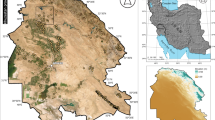Abstract
The study area is a part of Kagna river basin in the Gulburga district of Karnataka, India. It covers an area of 1320 km2 and it has been subdivided into 4 sub-basins namely Wadi, Chitapur, Sedam and Kurkunta, which range in area from 184 to 537 km2. The drainage pattern of these sub-basins are delineated using Geo-coded FCC bands 2,3,4 of IRS 1C and 1D(LISS III+PAN merged) on 1:50,000 scale and Survey of India toposheets as reference. The morphometric parameters are computed using ArcInfo and ArcView GIS softwares. The drainage pattern of the study area is dendritic to sub-dendritic with stream orders ranging from IV to VII orders. Drainage density ranges from 1.40 to 1.86 km/km2 suggesting coarse to moderate drainage texture. The change in values of stream length ratio indicate their late youth stage of geomorphic development. The values of bifurcation ratio ranging from 2.00 to 4.71 indicate that all the sub-basins fall under normal basin category. The values of form factor and circulatory ratio, suggest that the Kurkunta sub-basin is elongated and the remaining sub-basins are more or less circular in shape. Elongation ratio indicates that the Wadi sub-basin is a region of very low relief whereas the other sub-basins are associated with moderate to high relief and steep ground slopes. It is concluded that remote sensing and GIS have been proved to be efficient tools in drainage delineation and updation. In the present study these updated drainages have been used for the morphometric analysis.
Similar content being viewed by others
References
Chopra R, Raman Deep Dhiman and Sharma PK (2005) Morphometric analysis of sub-watersheds in Gurudaspur district, Punjab using Remote sensing and GIS techniques. J Indian Soc of Remote Sensing 33(4):531–539
Clarke JI (1966) Morphometry from maps, Essays in geomorphology, Elsevier Publ. Co., New York. pp 235–274
Foote RB (1876) The geological features of southern marhatta country and adjacent districts. Mem Geol Surv India XII(1):70–164
Gottschalk LC (1964) Reservior sedimentation in: VT Chow (ed) Hand book of Applied Hydrology. McGraw Hill Book Company, New York. Section 7-1.
Horton RE (1932) Drainage basin characteristics. Trans Am Geophys Union 13:350–361
Horton RE (1945) Erosional development of streams and their drainage basins; Hydrophysical approach to quantitative morphology. Geol Soc Am Bull 56:275–370
King W (1872) The Kudapah and Karnaul Formations in the Madras Presidency. Memoir Geological Survey of India 8:1–346
Kale VS, Mudholkar AV, Phansalkar VG and Peshwa VV (1990) Stratigraphy of the Bhima Group. Journal of the Palaeontological Society of India 35:91–103
Mahadevan C and Kazim Syed (1947) The Bhima series and other rocks of Gulburga districts. Journal of Hyderabad Geological Survey 5(1):1–60
Malur MN, Nagendra R and Rudraiah M (1985) A study of stylolites of Bhima basin (late Precambrian), Karnataka. 5th IAS Convention Volume. pp 161–174
Malur MN, Nagendra R and Rudraiah M (1988) Pressure solution structures in Bhima carbonate rocks (late Precambrian) Karnataka. Science and Culture 54:195–196
Malur MN, Rudraiah M and Nagendra R (1991–92) Microstylolites from Kurkunta Formation, Bhima Group (eastern part), Karnataka, South India. Jour of Mysore University; Section B. pp 188–190
Malur MN and Nagendra R (1994) Lithostratigraphy of the Bhima Basin, India (Central part), Karnataka, Southern India. Journal of the Palaeontological Society of India 39:55–60
Mathur SM (1977) Some aspects of stratigraphy and limestone resources of the Bhima basin. The Indian Mineral 18:59–64
Nag SK (1998) Morphometric analysis using remote sensing techniques in the Chaka sub-basin, Purulia district, West Bengal. J Indian Soc Remote Sensing 26(1&2):69–76
Nag SK and Chakraborty S (2003) Influences of rock types and structures in the development of drainage network in hard rock area. J Indian Soc Remote Sensing 31(1):25–35
Rao JLH, Srinivasa Rao C and Ramakrishna TL (1975) Reclassification of the rocks of Bhima basin, Gulburga district, Mysore state. GSI, Misc Publication 23(1):177–184
Schumn SA (1956) Evolution of drainage systems and slopes in Badlands at Perth Amboy. New Jersey. Geol Soc Am Bull 67:597–646.
Singh S and Singh MC (1997) Morphometric analysis of Kanhar river basin. National Geographical J of India 43(1):31–43
Smith KG (1950) Standards for grading textures of erosional topography. Am Jour Sci 248:655–668
Strahler AN (1957) Quantitative analysis of watershed Geomorphology. Trans Am Geophys Union 38:913–920
Strahler AN (1964) Quantitative geomorphology of drainage basin and channel networks. In: VT Chow (ed), Handbook of Applied Hydrology, McGraw Hill Book Company, New York, Section 4
Vittala SS, Govindaiah S and Honne Gowda H (2004) Morphometric analysis of sub-watersheds in the Pawagada area of Tumkur district, South India, using remote sensing and GIS techniques. J Indian Soc of Remote Sensing 32(4):351–362
Author information
Authors and Affiliations
Corresponding author
About this article
Cite this article
Rudraiah, M., Govindaiah, S. & Vittala, S.S. Morphometry using remote sensing and GIS techniques in the sub-basins of Kagna river basin, Gulburga district, Karnataka, India. J Indian Soc Remote Sens 36, 351–360 (2008). https://doi.org/10.1007/s12524-008-0035-x
Received:
Accepted:
Published:
Issue Date:
DOI: https://doi.org/10.1007/s12524-008-0035-x




